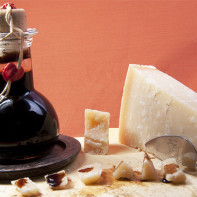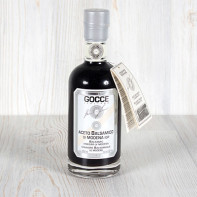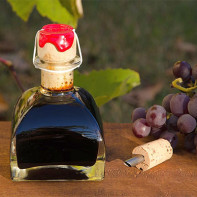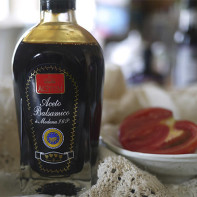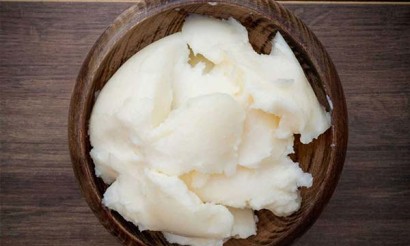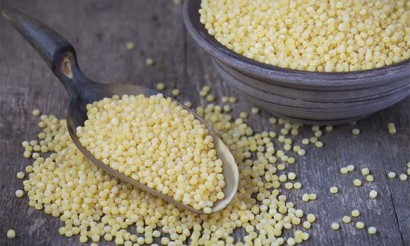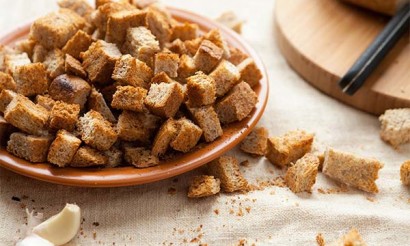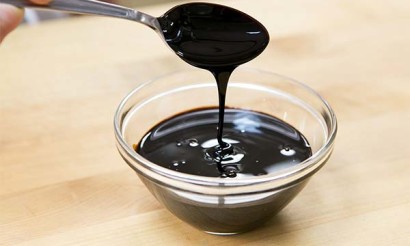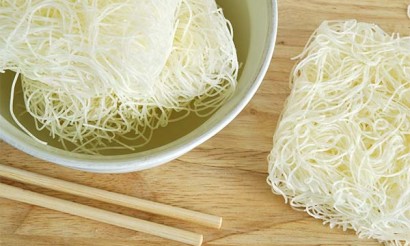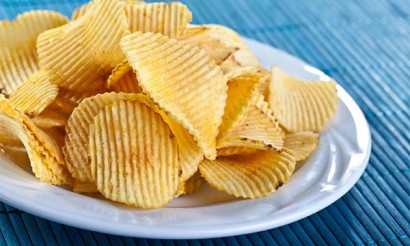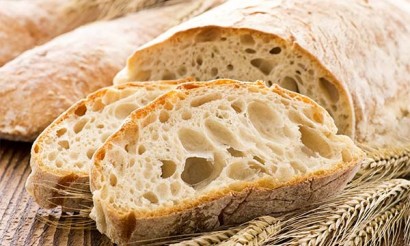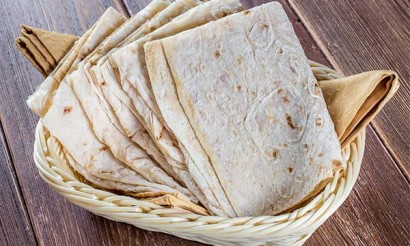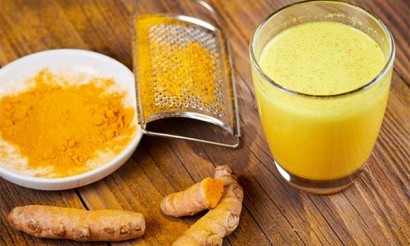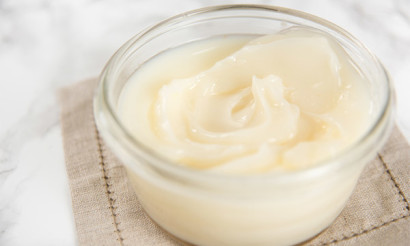Balsamic vinegar: what is it made of, useful properties and harms
There are more than ten varieties of vinegar, and they all differ in some characteristics. Balsamic vinegar - one of the most valuable types, as it has a lot of useful properties, pronounced taste qualities and bright aroma. Few people know that balsamic vinegar is not just a flavorful condiment to culinary dishes, but also a means, which is used to improve the health and care of the skin and hair.
- What is balsamic vinegar and what is it made of
- Types
- How it differs from ordinary vinegar
- How it differs from wine vinegar
- Composition and Calories
- What is Balsamic Vinegar Good for?
- For Women
- For Men
- When Pregnancy
- Breastfeeding
- For children
- When losing weight
- Traditional Medicine
- Balsamic Vinegar in cosmetology
- For Face
- For hair
- For the Body
- How to use in cooking
- What can be substituted for it
- Hazards and contraindications
- How to choose and store balsamic vinegar
- How to make balsamic vinegar at home
- Interesting Facts
What is balsamic vinegar and what is it made of
Balsamic vinegar is a solution of acids that are formed as a result of the fermentation of grape juice. The product originated in Italy, but the exact information about the creation of its recipe has not survived to the present day. The first mentions concerning the use of balsamic vinegar date back to 1034 AD. For some time, this product was distributed only in Italy, and the recipe was kept in the strictest secrecy. Only very wealthy families could afford to use such vinegar. This is not surprising because the technology is quite sophisticated.
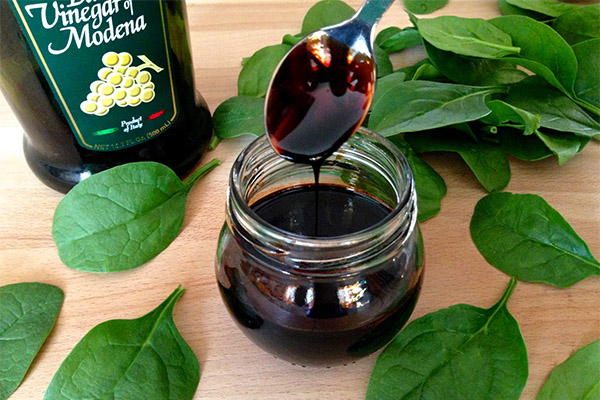
Here is how real balsamic vinegar is prepared according to the classic recipe:
- First, the must (thick juice with pulp) is obtained from white grapes.
- Then a special method evaporates excess water from it, boiling it down to a thick state.
- The resulting caramel grape syrup is poured into natural wood barrels.
- The syrup is left to stand for at least 20-25 years.
Depending on the wood used for the barrels, the taste and aroma of balsamic vinegar differs. Most often used in the creation of this product barrels from these types of wood:
- oak;
- cherry;
- maple;
- ash;
- mulberry tree (mulberry).
In the preparation of vinegar according to the classic recipe several types of barrels are used at once. After the liquid is aged in a large barrel, e.g. of oak, it is poured into a medium container made of another wood. After a few years, the product is poured into the smallest mulberry or cherry barrel. When the vinegar has finally matured, a portion from the barrel is bottled and sent for sale, and then a new batch of fermentation syrup is poured into the leftovers.
Vinegar created by this recipe is quite expensive, but it has amazing taste and pronounced health benefits. When they first started producing this product, it was used exclusively for medicinal purposes, which is why it was called "balsamic vinegar".
Types
There are many different varieties of sauces with the name "balsamic vinegar," but in most cases it is just a fake. There are only 2 types of this product, which correspond to the recipe and production technology.
- "Aceto Balsamico Tradizionale" is the label of high quality balsamic vinegar prepared according to traditional recipes and aged for at least 25 years according to all requirements.
- There are other varieties of the product, which have different labels, but at the same time on the bottles indicates the period of aging - from 12 to 15 years.
There are also different varieties depending on the period of aging. In addition, there is a version of balsamic vinegar that can often be found on supermarket shelves. It is relatively inexpensive, but that's because it has nothing to do with the traditional product. It is sold under the label Balsamic Vinegar of Modena.
This is just the name, in fact, under such a label wine sauce is sold, which only remotely resembles the aroma and taste of the real product, and it is prepared not from the juice of grapes, but from wine. The main disadvantage of such labeled fake wine sauce is that it contains toxic dyes and aromatic additives, some of which can cause harm to your body.
How it differs from ordinary vinegar
Balsamic vinegar is fundamentally different from the usual table solution of acetic acid 9%. The first difference is the color. Table vinegar is always completely transparent, it gives no sediment and looks like plain water. Balsamic vinegar is fundamentally different in color - it has a rich brown hue. Depending on the age of this product can be lighter or darker.
The second difference is the aroma. Everyone knows what ordinary vinegar smells like - unpleasant, pungent and sour aroma. But balsamic vinegar smells virtually no acid, it gives off a distinctly delicate fruity aroma. Depending on what wood was used to make the container in which the grape must was infused, the smell of balsamic vinegar will also differ.
The third difference is, of course, the taste. They are incomparable. While ordinary table vinegar is only sour and scalding to the taste, balsamic vinegar is many times more pleasant. It has a delicate, sweet and sour taste, with slight notes of tartness. Just his taste is able to complement and reveal the taste of any dish, salad or snack. Balsamic vinegar is successfully used for appetizers, side dishes and first courses, as well as for some desserts.
How it differs from wine vinegar
Wine vinegar can't be considered similar in taste or smell, either. The only thing they have in common is that both are made from grapes. But wine vinegar is a translucent liquid of dark or amber color, while balsamic vinegar is thick and dark brown. In addition, there is a difference in taste - wine product is more sour, has a pungent smell, although it has fruity notes. The technology of preparation is also significantly different - wine vinegar is an acid obtained by fermentation of wine.
Composition and calories
Balsamic vinegar has almost no vitamins, but this does not make its composition any less valuable. The fact that for a long time, the organic substances called vitamins decompose. The product contains a mass of other substances that are no less beneficial to human health.
The main components of the product are:
- zinc;
- magnesium;
- manganese;
- iron;
- iodine;
- potassium.
Vinegar also contains antioxidants, organic acids. They play a key role because they have a significant effect on the body. In addition, it should be noted that vinegar contains complex compounds - polyphenols, which reduce the activity of cancer cells or prevent their appearance.
Vinegar contains no fats at all, and proteins are present in a minimal, insignificant amount of 0.5 g per 100 g of product. But this type of vinegar is rich in carbohydrates - they are about 19.5 g per 100 g. But this is not a problem. The product has low calories: 1 tablespoon contains no more than 15 kcal. For comparison, the same amount of olive oil contains about 100-120 kcal. In 100 g of the product not more than 96 kcal, so people who control body weight can safely include in their diet this useful and tasty additive.
What is the usefulness of balsamic vinegar
A mass of useful properties of this product made it world famous long before the 20-21 centuries. In the old days, it was a basic medicine that every successful physician of the Middle Ages had with him. Of course, today medicine has made a huge leap and no one treats diseases with food, but vinegar is still used as an auxiliary component. This is not surprising, because it has a wide range of useful properties and pronounced effectiveness.
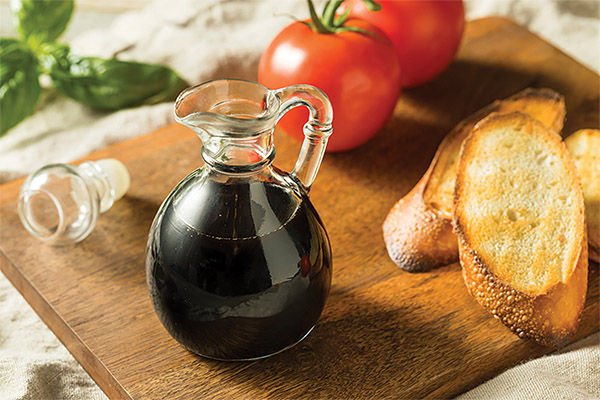
For women
Balsamic vinegar contains special compounds - polyphenols. They help to fight free radicals, which can provoke the activation of premature aging processes. Also, balsamic vinegar is useful because it reduces the risk of breast cancer by 60% and prevents problems related to the reproductive system.
For Men
The antioxidants in the product protect men from common cancers that affect the reproductive system. This product contains substances that regulate hormonal metabolism and prevent diseases associated with testosterone deficiency. In addition, organic acids can stimulate the production of enzymes and gastric juice, which significantly helps the efficient digestion and assimilation of food. This is extremely important because, statistically, men are more prone to develop gastrointestinal diseases, and at an early age.
When pregnant.
For pregnant women, balsamic vinegar can be a real salvation. The fact is that it has an antipyretic effect. It is used for compresses and rubs in those situations where the reception of drugs is contraindicated. In no case you should not rub the abdomen of a pregnant woman, because it is a risk to the fetus.
Also eating balsamic vinegar is very useful for women during pregnancy. During this period, the body wastes a huge amount of minerals so that the baby can actively develop. Balsamic vinegar in the diet is an ideal product to make up for iron, magnesium, zinc deficiencies.
There are no contraindications to the use of vinegar during pregnancy. But this applies only if the pregnancy proceeds normally, there are no threats or pathologies. Otherwise, you should consult a gynecologist. It is categorically contraindicated to use this product in the diet during gestosis (late toxemia). It can lead to impaired kidney and liver function, to serious edema and a threat to the health of the baby.
When breastfeeding
Breastfeeding is quite a long period in the life of a young mother. Therefore, it is difficult for 1-1.5 or even 2 years to abstain from familiar foods. In fact, balsamic vinegar is not forbidden during breastfeeding, but it should be introduced into the diet after 6-8 months, as it has a pronounced laxative effect.
Many women note that adding balsamic vinegar to the diet promotes lactation. Magnesium and antioxidants, which penetrate into the mother's milk, enter the baby's body, due to which it improves sleep, increases resistance to infections. But before introducing balsamic vinegar into the diet of a nursing mother, it is necessary to consult a pediatrician.
For babies.
Balsamic vinegar is not recommended for children under the age of three. But it can also be used for compresses and rubs for fever. Children over the age of six can gradually introduce this product into the diet, but it is important to watch the reaction of the body. Not all children tolerate sour sauces equally well - this is due to the peculiarities of the digestive system at different stages of development. Contraindications to the use of balsamic vinegar for children are the same as for adults.
When losing weight
Balsamic vinegar is successfully used for weight loss purposes, and it can be used both externally and internally. Because of its high concentration of fruit acids, balsamic vinegar helps accelerate metabolic processes as well as activates lipolysis (breaking down of fats by the body in order to obtain energy). The most popular procedure that allows you to burn fat locally is wraps with balsamic vinegar. Step-by-step instructions:
- Expose the skin - take a hot shower or bath.
- Take a piece of clean cotton cloth and soak it in balsamic vinegar diluted with water in a 1:1 ratio.
- Wrap the problem area of the body.
- Cover the top tightly with clingfilm to create a greenhouse effect.
- Do not remove the compress for 2 hours, and after unwinding the film and cloth, take a shower.
The procedure should be repeated at least twice a week for one month. Before starting a course of wraps, you should test the skin for sensitivity - put a small amount of vinegar on the wrist and leave it for 20-30 minutes. If the skin is not red, then you can use it to lose weight.
Contraindications to the use of vinegar wraps are serious vascular diseases, high temperature, critical days, as well as chronic and acute inflammatory processes in the pelvic organs.
In addition to wraps, salads with balsamic vinegar can also be used for weight loss. Due to the fact that this sauce contains absolutely no fat, but has a viscous, viscous consistency, it can be used instead of traditional dressing, reducing the caloric content. Also in a plant-protein diet, the addition of balsamic vinegar is especially useful, as it promotes easy digestion of vegetables and greens, lean protein animal products.
Application in folk medicine
The use of balsamic vinegar in folk medicine is widespread, moreover, when it was just created, its main task was to treat various diseases. Due to the fact that the product in question has pronounced therapeutic properties, it is actively and still used by supporters of alternative medicine as an auxiliary means. There are at least 8 applications of balsamic vinegar in alternative medicine.
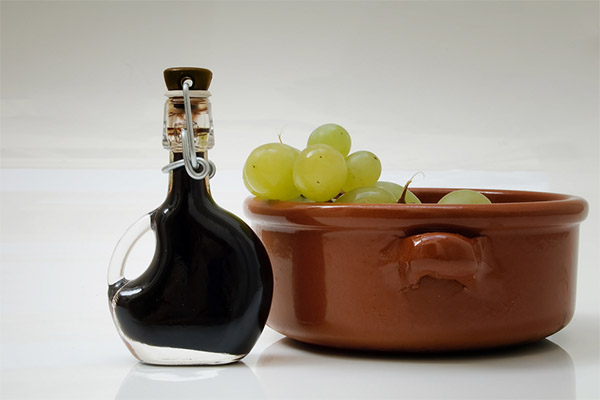
- For diabetes, a small amount of balsamic vinegar is used - up to 20 ml per day. It is desirable to take it in the first half of the day or immediately after consuming carbohydrates. The product activates the processes of breaking down glucose and processing its molecules into energy.
- Balsamic vinegar is successfully used to treat vascular diseases - couperose, varicose veins (only in the early stages). It can be used alone to rub the problem areas 1-2 times a day. You can dilute in a ratio of 1:1 cabbage juice and use for two-hour compresses.
- Balsamic vinegar is used to normalize the functioning of the nervous system - for insomnia, anxiety disorders, memory loss. Prepare a mixture of honey, ground nuts and balsamic vinegar. Take 1 teaspoon three times a day.
- Since ancient times and to this day, balsamic vinegar has been used to treat skin diseases as part of homemade ointments, compresses. Compresses with this product help with boils, accelerate tissue regeneration. But by no means can vinegar be used for bacterial rashes!
- With the help of balsamic vinegar you can prolong your life and make your heart healthier. It contains potassium, which supports water-salt balance in the body, as well as magnesium, which does not let the heart muscle age. For prevention, you need to take 1 tablespoon of the product per day, you can take it as part of other dishes.
- For constipation and flatulence, folk medicine uses balsamic vinegar - ½ teaspoon per 100 ml of water. Drink such a solution three times a day, but not longer than 10 days.
- Balsamic vinegar is used in various dermatitis, and also helps to eliminate itching from insect bites. In dermatitis apply a thin layer, like a cream, on the pre-cleaned skin for literally 10-15 minutes. In case of insect bites it is necessary to apply locally.
- In cholecystitis or gallbladder diseases associated with bile stagnation, you need to take ½ teaspoon of balsamic vinegar 10 minutes before a meal. This should be done before each meal so that the gallbladder can eliminate excess bile.
Folk medicine is the knowledge accumulated over the centuries, which is available to mankind today due to the observation of many generations. But not all unconventional techniques work, sometimes they can cause harm to health. Therefore, before using any of the recipes, it is worth consulting a doctor and adhering to his recommendations.
Balsamic Vinegar in Cosmetology
The use of balsamic vinegar for cosmetic purposes originated in Italy. To this day, this product is popular as an ingredient in home high-performance cosmetics. But that's not all - many manufacturers of elite care products also have not neglected the useful properties of the product. Today there are on sale the whole lines of medicinal and everyday cosmetics, created on the basis of this product. For those who do not want to spend time and money on the search and purchase of professional caring cosmetics, below are collected home beauty recipes.
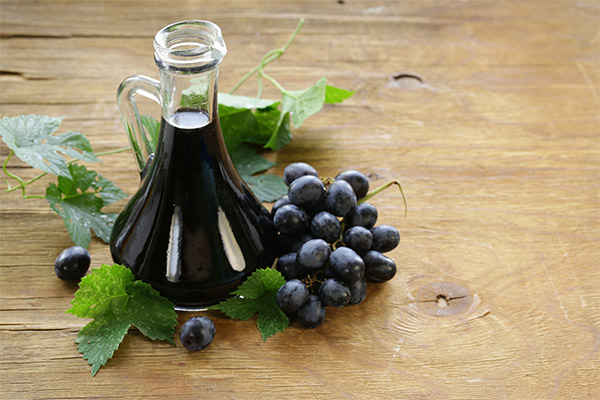
For Face
The product can be used for all skin types. The exceptions are serious diseases, dermatitis, extensive inflammatory processes. But this is not a categorical contraindication, but a temporary one. Vinegar has the ability to bleach the skin, eliminate black spots and oily shine, tighten, improve the complexion. Therefore, you can safely use it to create a perfect facial contour, purify and even out skin tone. There are 2 popular recipes that will save in any situation:
- A lightening and smoothing skin tone mask is prepared with egg yolk and balsamic vinegar (1 teaspoon). It should be applied in an even layer on the skin, avoiding the eye area. Wash off after 10-15 minutes. Repeat 2-3 times a week, preferably in the evening.
- The second option is a nourishing anti-wrinkle mask. In a small bowl mix 1 teaspoon of vinegar and the same amount of turmeric, add ½ teaspoon of olive oil, mix and apply along the massage lines. After 20 minutes, wash the mixture off with warm water and a cleanser so that the oil does not remain in the pores.
An important nuance - after each use of the product in the care of the appearance it is necessary to apply a cream that protects against UV rays, as the sensitivity of the skin increases.
For hair
The useful properties of balsamic vinegar can also be used in hair care - it can solve many problems. Due to its high mineral, antioxidant and organic acid content, this type of vinegar can be used as a component in the creation of hair care and treatment products.
- A classic version of a caring mask, suitable for all hair types is a mixture of olive oil, balsamic vinegar and lime juice. All ingredients should be taken in equal proportions. Apply the mixture to the roots of the hair first, and then distribute it with a comb on the entire length. Rinse after 20-30 minutes.
- If your hair grows badly, a mixture of natural burdock oil and balsamic vinegar will help. When hair loss, you can add to these ingredients also ground red pepper. It stimulates the hair follicles, awakening them to growth.
- For the care of colored hair, a balm prepared on the basis of wine and balsamic vinegar is used. They should be mixed in equal proportions, and then diluted with cold boiled water, also in a ratio of 1:1. Apply the balm to clean, damp hair, and after 3-5 minutes rinse with warm water.
- For dandruff use this remedy - 1 tablespoon of balsamic vinegar, 2 tablespoons of aloe juice, 5 drops of tea tree essential oil. Apply the mixture after washing your head for 20-30 minutes, repeating 2 times a week. Rinse off with lukewarm water.
- If the hair gets greasy quickly and looks ungroomed, it is easy to reanimate it. You need to mix 1 tablespoon each of wine, balsamic and apple cider vinegar. Dilute this mixture with a liter of warm water and use it to rinse your hair after shampooing.
Balsamic vinegar gives pronounced results, but you need to use it regularly and make sure that there are no contraindications. If, however, after using the product, the scalp reddened, itching and rash began, you need to immediately stop using it and consult a doctor to eliminate the allergic reaction.
For the Body
Balsamic vinegar can become the main grooming agent on the shelf in the bathroom, because it gently cares for the skin of the body and is suitable for absolutely everyone who is not allergic to it. There are four popular recipes that have long been used by Italian women and handed down from generation to generation.
- A mixture of balsamic vinegar and honey, to which you can add a small amount of grated chili pepper helps effectively against cellulite. The mixture should be kept in the refrigerator for 2 weeks, using every evening for a five-minute massage on the problem areas. In 1 month you can get rid of cellulite and forget about it.
- To make your body skin silky, without roughness and goose bumps, you need to exfoliate periodically. The best remedy for the body is a mixture of balsamic vinegar and brown sugar. You can supplement the prepared scrub with 2-3 drops of orange essential oil.
- To soothe the skin after shaving or depilation, you can prepare a revitalizing and cooling balm. Mix a spoonful of cucumber juice and balsamic vinegar, add 1 ml of medical alcohol and a couple of drops of menthol oil. Apply for 2-3 minutes, then rinse and use a moisturizer. The result is that the irritation goes away 2-3 times faster.
- Balsamic vinegar is a safe and effective way to care for the skin of the feet. It can be added to water with tea tree essential oil for increased foot sweating. You can also make compresses to soften the skin of the feet while performing pedicures.
The skin of the body with regular use of these products will become softer, there will be a healthy glow. The rate of cell regeneration will increase and it will be possible to maintain freshness and elasticity for many years.
How to use in cooking
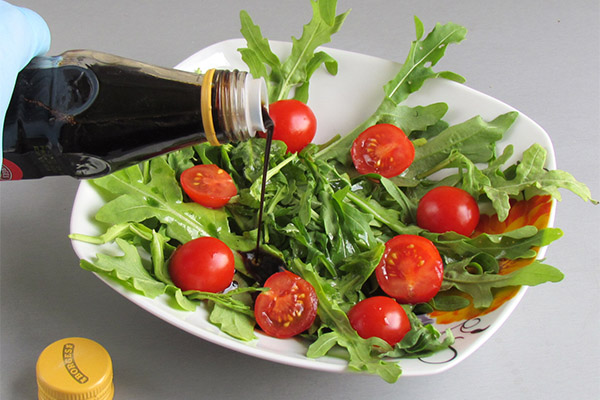
In cooking, balsamic vinegar is used as a base for sauces, salad dressings. Perfectly combines with such products:
- meat;
- mushrooms;
- fish;
- vegetables;
- herbs;
- fruits.
It is used in the preparation of appetizers to reveal and emphasize the taste of the main products. Also balsamic vinegar is an ideal dressing for fresh vegetable salads and the basis for marinades.
What you can replace it with
The taste and smell of the product is unique, so it is difficult to replace it. But you can use a mixture of soy sauce with honey and wine vinegar. Also a great alternative would be a mustard-honey sauce with lime juice. But any of the above options can not one hundred percent replace a natural, high-quality product.
Harms and contraindications
Not always the use or consumption of balsamic vinegar is beneficial. If you take it in the presence of contraindications, you can only make it worse for the body. Therefore, it is important to know under what conditions and diseases the use of this remedy is strictly contraindicated.
- All types of vinegar are categorically forbidden in cases of gastric and duodenal ulcers, hyperacidity, gastritis and colitis in the acute stage, diarrhea, food infections and other disorders of the digestive tract.
- Do not take or use externally this product if it provokes an allergic reaction or is poorly tolerated by the body.
- It is forbidden to use balsamic vinegar for venous thrombosis in the last stages of development, because it significantly dilutes the blood and can lead to serious health problems.
- Do not use the product in acute pancreatitis and cholecystitis, as it stimulates the production of digestive enzymes and bile, which can only aggravate the condition of the patient. During remission it is possible to introduce this product into the diet, but only with the permission of the attending physician.
- It is not recommended to abuse the product for those who have been diagnosed with type II diabetes. The fact is that this type of vinegar is extremely rich in carbohydrates and contains fructose, which can significantly increase blood sugar levels.
- The use of balsamic vinegar is contraindicated in various bleeding, as well as inadequate blood clotting. It dilutes blood, cleanses blood vessels and can lead to increased bleeding, and this, in turn, is already dangerous not only for health, but also for life.
- Balsamic vinegar is contraindicated in cystitis, nephritis or other diseases of the urinary system, especially in the acute stage. Acids can irritate the inflamed mucous tissue, provoking a worsening of the condition.
It is not recommended to abuse balsamic vinegar, even if there are no contraindications. In any case, it is a product rich in acids, so its excess can upset the balance in the body, leading to the appearance of side effects.
In rare cases, unpleasant symptoms may occur after using or consuming the product:
- heaviness and abdominal pain;
- diarrhea;
- heartburn;
- loss of appetite;
- frequent urges to urination.
A temporary contraindication is a sore throat, acute respiratory infections and colds. The fact that acids irritate the mucous membranes and can lead to a worsening of the state of health. Often, the abuse of vinegar leads to unpleasant symptoms in the throat. If this happens, it is better to refrain for a week from eating the product, acidic and spicy food.
Healthy people with no contraindications can use balsamic vinegar even every day. But it is especially useful in combination with fatty meat and fish dishes, with other protein foods of animal origin, which is difficult for the body to digest.
How to choose and store balsamic vinegar
Today, it is quite difficult for anyone who does not live in Italy to buy real balsamic vinegar and distinguish it from fakes. Still, knowing a few tricks, everyone can cope with this task. So, tips for choosing and buying a quality product.
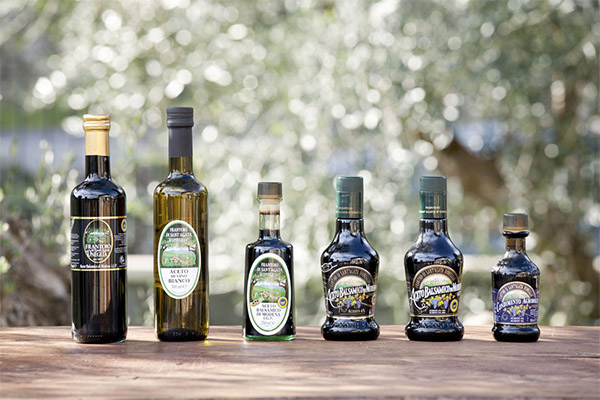
- If you need to buy a natural product, you should pay attention to variants with the Tradizionale name and a DOP marking.
- It is important to pay attention to the country of origin - a high-quality product to this day is made only in Italy.
- If the package has the inscription Aceto balzamico di Modena, as well as the marking IGP - this is a sauce from the province of Modena, you can not doubt its quality.
- If it says Condimento on the sauce, it is not pure balsamic vinegar, but a product that contains various flavors.
- It is worth paying attention to the variety. A first grade product is the best option. The second and third grade are vinegars that have less than 20 years of aging.
- It is important to pay attention to the brand logo - if there is no logo, you should not buy such a product, most likely, it is a fake.
And, of course, the price is an indicator of quality. Good balsamic vinegar is expensive enough, so it is not sold in supermarkets and retail chains.
How to make balsamic vinegar at home
Only the most patient can make balsamic vinegar at home, because it will take at least 12 years. You need to buy ripe grapes of white varieties and suitable containers - barrels made of natural wood. You can take juniper, thuja, oak or cherry barrels. Step-by-step instructions:
- Mash the grapes and strain the juice through a sieve;
- In a pressure cooker or in a pot boil it over low heat;
- Pour the boiled grape juice into a wooden barrel and leave it to ferment.
If you plan to age it for 12 years, every 4 years transfer the mixture to a smaller barrel, cover it and leave it in a dark, dry place. After 12 years, you can send a small part of the product to Italy, the home of balsamic vinegar. If it meets all the requirements, the manufacturer will receive a certificate confirming the quality of the product.
Interesting Facts
Balsamic vinegar has existed for more than 1,000 years. Therefore, during this period it has managed to turn into myths, misconceptions, which are practically dispelled by modern science. In addition, in the history of the use of balsamic vinegar, there are many interesting facts that are worthy of attention.
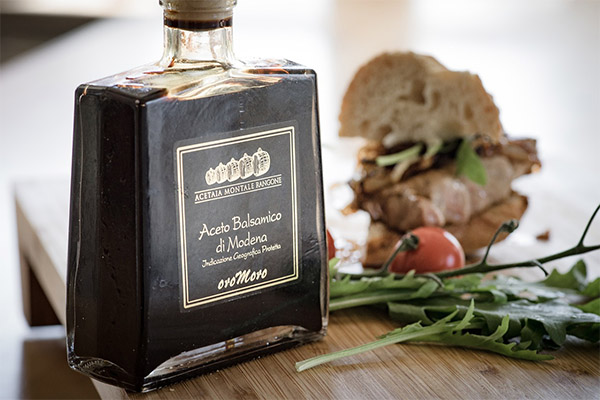
- In ancient times, a barrel of balsamic vinegar was part of the dowry of every rich bride of high society.
- In ancient times, every aristocrat, nobleman or simply rich man had his own recipe for vinegar, which was kept in the strictest secrecy.
- Previously, the entire dynasties were engaged in the production of this product, and the equipment necessary for its manufacture, along with the secrets and skills, was passed on by inheritance.
- In 2012, Chinese scientists conducted large-scale research and experiments involving animals. In the course of the research they managed to find out that balsamic vinegar prolongs youth and reduces the risk of cancer. The same experiments with humans have not yet been conducted.
- One of the Italian kings gave a barrel of balsamic vinegar to the ruler of a neighboring country, and it was a decisive step in building relations. In addition, he thereby founded among the rulers the tradition of giving each other gifts, which still exists to this day.
As you can see, balsamic vinegar, although it is a rare product, but it has pronounced useful properties, and can also be used to treat various diseases. The main thing is not to forget about the recommended rate and not to abuse it.
«Important: All information on the site is provided solely for introductory purposes. Before applying any recommendations, consult a specialist. should be consulted with a health care professional before any of the recommendations are used. Neither the editors nor the authors shall be liable for any possible harm caused by materials."

